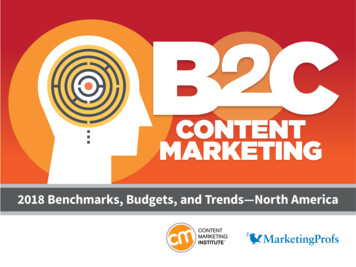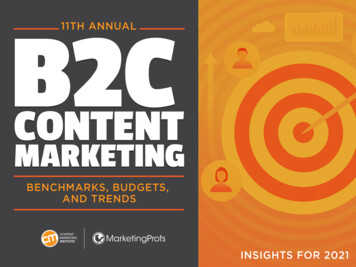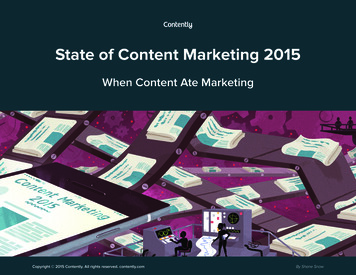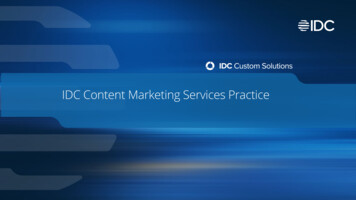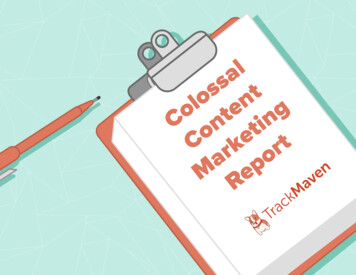
Transcription
The Content MarketingProcessA study on shopping centre’s content marketing processBACHELOR THESIS WITHIN: Business AdministrationNUMBER OF CREDITS: 15 ECTSPROGRAMME OF STUDY: Marketing ManagementAUTHOR: Tom Löfgren & Sara UtterbergTUTOR: Imoh AntaiJÖNKÖPINGMay 1016
AcknowledgementsFirst of all, we would like to thank the management of a6 for all the help and supportthroughout the research process. Your nice treatment of us as students was highlyappreciated.Additionally we would like to acknowledge our tutor Imoh Antai for his support andguidance throughout our thesis writing process.Tom LöfgrenSara UtterbergJönköping International Business SchoolMay 2016i
Bachelor Thesis within Business e Content Marketing ProcessTom Löfgren & Sara UtterbergImoh AntaiMay 2016Content marketing, content marketing process, shopping centre, onlinechannels, website, Facebook, InstagramAbstractBackground: Content marketing is an important marketing strategy; it involves pullingthe consumers towards a brand instead of pushing marketing on the consumers. Theonline presence among people is growing; therefore, it is important for business tomarket themselves online, via online channels.Problem: A shopping centre with several different stores and concepts also has severaldifferent audiences to keep track of. Delivering valuable content towards the audience isnot an easy task. This can also be harder when dealing with different types of audiences,just like in the case of a shopping centre.Purpose: The purpose of this thesis is to investigate the content marketing process of ashopping centre towards suggestions and recommendations from literature in order tofind how they relate to each other. This thesis also aim to establish how a chosenshopping centre segment perceive content being distributed to them.Method: This research was based on a case study of a6 shopping centre. Bothqualitative and quantitative data was collected for the purpose of this research.Interviews and observations were conducted in order to establish how a6 works withcontent marketing and a survey was carried out in order to establish how a chosenshopping centre segment perceive content being distributed to them.Conclusion: Shopping centres can follow the overall content marketing processstructure suggested by literature. However, due to scarce resources, they might not beable to follow every suggestion and recommendation made. The chosen consumersegment found inspiring content to be most interesting and educational to be the least.ii
Table of Contents1 Introduction . 11.1 Background . 11.2 Problem . 31.3 Purpose . 41.4 Research questions. 41.6 Delimitations. 41.7 Definitions . 52 Frame of Reference . 62.1 Content marketing process. 62.1.1 The CMI Content marketing framework . 73 Methodology . 163.1 Research model . 163.2 Case study . 173.3 Qualitative research . 183.3.1 Interviews . 193.3.2 Observations . 193.4 Quantitative research . 203.4.1 Survey . 203.5 Data analysis . 204 Empirical Findings . 224.1 Interviews . 224.1.1 Centre manager . 224.1.2 Centre-marketing manager . 234.2 Observations . 274.2.1 Instagram . 274.2.2 Facebook . 284.2.3 Website . 284.3 Survey . 294.3.1 Total 294.3.2 Differences between age groups . 315 Analysis . 325.1 Plan 325.2 Audience . 335.3 Story . 335.4 Channels . 345.5 Process . 355.6 Conversations . 365.7 Measurement. 365.8 Summary of analysis. 396 Conclusion . 407 Discussion . 41References . 43iii
Appendices . 47Appendix 1. 47Appendix 2. 48Appendix 3. 52iv
FiguresFigure 1 The Content Marketing Framework .8Figure 2 The research 'onion' 16Figure 3 Types of Case Studies .18Figure 4 Rearranged model structure of the CMI framework 39v
1 IntroductionThe first section consists of a short background about content marketing and shoppingcentre followed by a problem discussion. The problem discussion is followed by thepurpose, which presents the focus of this thesis. The specific research questions arepresented and finally a couple of definitions are defined in order to make some keywords clear.1.1 BackgroundContent marketing is providing information that gains consumer attention rather thanbuying the attention with advertising or trying to affect them with one at the timetraditional sales techniques (Ryan, 2014). Content marketing is not a new phenomenon,today content marketing is a must-have strategy for companies. The content has to berelevant, high quality and add value to the consumers (Lieb, 2011). Content marketingis all contents that add value and can both directly or indirectly market a business(Gunelius, 2011). A brand voice and identity can be shaped and created through contentmarketing. There are several types of content such as; digital newsletters, emails,images, videos and social content that is created exclusively for social networks.Content is aimed to market a company’s product or service by entertaining and helpingthe consumer (Odden, 2012).Content marketing is a pull-strategy, where consumers seek you out rather than youpushing marketing on them. As a business, it is an advantage to have consumers comingto you because it means that they are interested and curious (Lieb, 2011). Contentmarketing can be used both offline and online. Businesses do not want to interrupt theconsumers but rather engage them through their content marketing in order to achievesuccess (Gunelius, 2011). According to Odden (2012), consumers do not care forinterruption marketing, they want to be entertained and educated. Consumers expectvalue of some kind from brands, such as easy discovered content that they can interactwith and share with others. Content creates customer engagement and it could helpeducate prospects about services or products and guide them through the buyingprocess.The online presence among people is growing, comparing the annual statistics ofinternet use from Statistics Sweden (2013 and 2014) one can see an increase in usingthe internet for posting messages to social network sites, chat sites, and blogs from 2013to 2014. According to the statistics, the increase among private persons was noticeablein every age group examined. Statistics Sweden also releases an annual statistics reportwith focus on enterprises and their Internet usage. The report from Statistics Sweden(2013) research the usage of social media amongst enterprises and it shows that almost1
half of the enterprises in Sweden have a social media presence (Statistics Sweden, ICTusage in enterprises 2013).There is not much to be found on trends, statistics and research when it comes tocontent marketing in Sweden. In matter of fact, the amount of research, statistics andtrends on content marketing is scarce in a global context as well. However, the twomarketing education organization's Content Marketing Institute (CMI) andMarketingProfs has in collaboration since 2013 released an annual B2C benchmark,budget and trends report on content marketers in North America.Every annual report, first tries to establish the most common tactics used by contentmarketers. The most popular tactic, social media, has been the same since the firstreport in 2013. There are several tactics used by content marketers, some of the mostpopular ones are providing articles on websites, e-Newsletters, illustrations/photos,videos and blogs (Pulizzi & Handley, 2013).Focusing on the most used tactic, one must consider that there are various social mediasites to use when distributing content. Facebook is clearly the most popular site to use incomparison to its competitors. The percentage of content marketers who use Facebookdecreased from 90 per cent to 89 per cent between 2013 and 2014, however thepercentage increased again to 94 per cent in 2015 and remained the same in 2016. OnlyTwitter has been close with its 84 per cent usage in 2015. However, whilst thepercentage of Facebook usage was the same between 2015 and 2016, Twitter decreasedby two percentage points to an 82 per cent usage in 2016 (Pulizzi & Handley, 2013,2014, 2015, 2016)Instagram, with its 20 per cent increase, was the social media site that took the biggestjump between 2013 and 2014. Since 2014, Instagram has been the social media site thatas shown the greatest usage increase amongst content marketers. The report from 2015,showed an increase of 17 percentage points for Instagram. In addition, the 2016 reportfurther established Instagram as the site increasing the most with its 13 percentagepoints change from the year before. In conclusion, according to the content marketinginstitution report, the percentage points of content marketers using Instagram hasincreased over the last four years with 12 in 2013, 32 in 2014, 49 in 2015 and 62 in2016 (Pulizzi & Handley, 2013, 2014, 2015, 2016).The annual reports also looks at the spending patterns and trends of North Americancontent marketers. In 2013, 45 per cent of the content marketers said that they wouldincrease their content marketing spending and 10 per cent said that they would increaseit significantly. An even higher percentage of content marketers said that they wouldincrease their spending in 201 when 45 per cent said that they would increase and 15 percent said that they would increase significantly. This adds up to 60 per cent of contentmarketers who would increase their content marketing spending in 2014 in comparison2
to 55 per cent in 2013. In 2015, the amount of content marketers increasing theirspending increased from 45 to 50 per cent, however the amount of marketers increasingsignificantly dropped from 15 to 9 per cent. In 2016, the report did not supply the samealternatives, thus changing the percentage quota. In conclusion, content marketers havebeen eager to increase spending on content marketing over the last four years (Pulizzi &Handley, 2013, 2014, 2015, 2016).This thesis will investigate content marketing through online channels for shoppingcentres. Content marketing could be carried out through a wide range of onlinechannels, however this thesis will be focusing on the online channels of social mediaand website. The main focus will be towards Facebook and Instagram since Facebook isthe most popular social media site for content marketers to use and that Instagram hasshown the biggest increase in the field over the last years (Pulizzi & Handley, 2013,2014, 2015, 2016).A shopping centre is a cluster of retail stores in a close geographical environment underthe same roof (Vitorino, 2012). A shopping centre usually has a variety of differentretail stores, from clothing to furnishing to toy stores. A consumer should expect to beable to do all errands under the same roof (Micu, 2013). According to Scott (1970) andBrown (1992), shopping centres are usually single-owned. The tenant mix is importantfor the attractiveness of the shopping centre, although as of today there is no perfecttenant mix strategy (Yim, Yui & Xu, 2012). Shopping centres are a brand themselvesand all the individual stores within a shopping centre have their own brands. Andtherefore, it is important for the shopping centre to market and advertise the centre as awhole instead of the marketing and advertising only coming from the individual storeswithin the shopping centre. The online presence amongst private persons is growing(Statistics Sweden, 2013 and 2014) therefore in order to reach those people shoppingcentres also need to have a presence online.In Sweden, shopping centres and trade areas keep expanding in size, number andrevenue. In 2014, nine new shopping centres and trade areas were built in Sweden, thisled to a total of 358 shopping centres and trade areas and this number is growing everyyear (HUI research, 2014). One key element for shopping centres is the attractivenessand one measurement of the attractiveness is the number customers’ (Micu, 2013).The rapid development of digital technology and new marketing opportunities due touse of social media and mobile devices creates great potential for businesses to reachconsumers in a fast and individualized way. However, this potential is unexploited ornot yet satisfactory utilized for many offline retail businesses (Ryan, 2014).1.2 ProblemAccording to Ryan (2014) every business that has an audience online or that is going tobe online needs to embrace some kind of online or digital marketing to retain and3
engage with them. Content marketing is providing information that gain consumerattention rather than buying the attention with advertising or trying to affect them withone at the time traditional sales techniques. One of the purposes of content marketing isto not disturb the consumers with pushing sales offers but rather pull the consumer inwith valuable content that they find interesting. Being sought out by an audience thatwants you to provide them with content is great, but being able to deliver that content inthe right way is what really makes a content marketing strategy successful (Jefferson &Tanton 2015). Delivering valuable content to a target audience consistently requireswork, originality, thought, strategy, experimentation and persistence. A surfeit ofpotential outlets add complexity to the decision on what content to provide, in whatform to provide it, how to display it and finally how to measure its effectiveness (Lieb,2011). Since a shopping centre is a cluster of retail stores in a close geographicalenvironment under the same roof (Vitorino, 2012), they have a wide range of consumersto satisfy. Having to satisfy such a wide audience might make the content marketingprocess more complicated.1.3 PurposeThe purpose of this thesis is to investigate the content marketing process of a shoppingcentre towards suggestions and recommendations from literature in order to find howthey relate to each other. This thesis also aim to establish how a chosen shopping centresegment perceive content being distributed to them.1.4 Research questionsThe research questions are guidance in order to achieve the purpose of this thesis:1. How is the content marketing process of a shopping centre implemented inrelation to what literature suggests and recommends?2. How does a chosen shopping centre segment perceive content being distributedto them?1.6 DelimitationsThis thesis has some delimitation in order to narrow down the topic of contentmarketing. One delimitation is the online channels that will be observed andinvestigated. When it comes to online channels, this thesis will focus on three differentchannels; website, Facebook and Instagram. Another delimitation is that the focus willbe on one single shopping centre instead of several ones. Due to lack of time andresources, this thesis will only to research one shopping centre rather than several ones.In the primary data collection of the survey, this thesis will focus on consumerperception of content marketing rather than the effects and consequences.4
1.7 DefinitionsContent Marketing: “Content marketing encompasses all forms of content that addvalue to consumers, thereby directly or indirectly promoting a business, brand, products,or services.” (Gunelius, 2011)Content Marketing Institute (CMI): “Content Marketing Institute is the leading globalcontent marketing education and training organization, teaching enterprise brands howto attract and retain customers through compelling, multi-channel storytelling.”(Content Marketing Institute, 2016)Digital newsletters: These online newsletters are often published according to aschedule and regularly provide a source of useful information, promotion, and links toweb pages that further engage readers (Odden, 2012).Online Channels: Interaction platforms where companies can interact and keep aconstant dialogue with consumers online (Jespersen, 2011).Shopping centre: “.a large cluster of retail stores in a close geographical proximity toone another.” (Vitorino, 2012)Social content: Content created exclusively for social networks like Facebook, Twitter,or LinkedIn have significant impact on awareness and engagement (Odden, 2012).Social media: Applications used online that get consumers to share experiences,opinions, reviews and insights (Kaplan & Haenlein, 2009).Valuable content: Valuable content is supercharged content with a purpose. Indistinction from just being content, valuable content is words, knowledge andinformation that is shaped and shared to customers and clients with the aim of beingeducational, helpful or inspiring. (Jefferson & Tanton 2015)5
2 Frame of ReferenceThe second section consists of a frame of reference dealing with the content marketingprocess. A few strategy frameworks are introduced. After this, for simplicity, steps ofone framework are chosen as a structure. To gain a deeper understanding of the contentmarketing process, additional literature complements every step.2.1 Content marketing processAccording to Jefferson & Tanton (2015), it is important to have a documented contentstrategy process and plan in order to have a clear picture of what should be achieved andhow to actually achieve it. Odden (2012) states that the content marketing strategy is aplan to deliver thoughtful and valuable content with certain outcomes in mind to achosen audience.Odden (2012), provides six steps for a better content marketing strategy.1. Objectives. Set to identify overall business goals for the content marketing.2. Audience. Develop profiles that represent characteristics of a customer segment.3. Content plan. Determine a content mix, topics and desired outcomes based oncustomer needs and business goals.4. Promotion. The promotion of content to end users and influence further sharingand conversations.5. Engagement. Grow social networks through listening and participating thathelps creation of future content.6. Measurement. Find out if the content marketing is being helpful for customersand if the content marketing strategy is fulfilling its objectives and goals.Jefferson & Tanton (2015) provides ten steps for a successful valuable contentmarketing strategy.1. Be clear on your goals. Setting objectives and goals for what areas of thebusiness the content marketing should improve.2. Know your business. Asking questions to the own business to determine whoyou are as a business, what you are selling and to whom, and what you want tobe known for in the future.3. Know your customers. Determine the ideal customer and their wants and needs.Research and create persona profiles of the ideal customer.4. Find your story. Decide the business purpose and its mission. A hashtag couldbe used to communicate the story in short.5. Your content sweet spot and vision. Find out what your business knows betterthan anyone else. Decide what kind of topics and attributes should define thecontent.6
6. Content commitment & plan. Set a content calendar and schedule a distributionand publishing plan.7. Platforms & tools Determine what content should be created and what creationand distribution tools are needed.8. Organize. Consider who should create the content and have the overallresponsibility for it. Find out if external skills are needed or if internal humanresources need to be trained.9. Measurement. Assess if the strategy is working successfully or not.10. Planning the change. Find out what should be changed in the set out a realisticimplementation plan to make it happen.The steps of objectives, audience, content plan and measurement mentioned by Odden(2012) are similar to the steps mentioned by Jefferson & Tanton (2015) but thepromotion and engagement step are not as emphasized. However, the two authors addmore steps to the content marketing process with more focus on platforms, tools, andinternal issues such as the vision.According to Joe Pulizzi, founder of the content marketing institute (CMI), there are noone-size-fits-all plans that could be applied to every organization. However, being ableto work with several brands to operationalize the process of content marketing, the CMIhave been able to spot some interesting patterns (Pulizzi, 2013). Pulizzi & Rose (2013)at the CMI have created a framework in the form of a chain that aim to increase thesuccess likelihood of one's content marketing. It includes the steps of Plan, Audience,Story, Channels, Process, Conversations and Measurement.The CMI framework is a simplified framework chain of the content marketing processthat covers the aspects of the content marketing process provided by both Odden (2012)and Jefferson & Tanton (2015) Since the framework covers the aspects mentioned byboth authors in a simplified manner, rather than examine the different suggestedcollection of steps one by one, the structure of the framework will be used to examinethe content marketing process in more literary detail.2.1.1 The CMI Content marketing frameworkThe framework developed by Pulizzi & Rose (2013) at the CMI, involves sevendifferent building blocks (see figure 1) that can be used to build up a content marketingstrategy. Figure 1 shows the seven building blocks, which are; Plan, Audience, Story,Channels, Process, Conversations and Measurement.7
Figure 1. Content Marketing FrameworkSource: Pulizzi & Rose,2013PlanThe first step of the CMI content marketing framework is plan. The framework statesthat no matter the marketing department size of one's business, planning is a core part inbeing successful. A business plan should be a thoughtful and strategic plan that alignswith and strive to meet the broader goals of the business. When developing a plan thereare some essential questions the plan should aim to answer such as what the businessshould try to accomplish, what makes the business unique and what differentiatingfactors the business holds. The framework further states that the fundamental purpose ofplanning is to understand who you are, where you are and where you want to be. Theframework emphasizes the importance of planning and says that planning should be acontinual process that works to optimize the marketing programs (Pulizzi & Rose,2013).Garner (2012) provides a strategy for planning that includes creating an editorial planand publishing calendar that will work as a production framework for the contentcreated. The editorial plan and publishing calendar should include asset types to thepublished, location of where content should be published and frequency. It is furtheradvised by Garner, that one should maintain a calendar of the content timeline onemonth in advance in order to avoid creating content on the fly. Jefferson & Tanton(2015) also emphasizes the potential benefits of using a content calendar and toschedule a distribution and publishing plan.The framework by Pulizzi & Rose (2013) states that the business plan should be astrategic plan that aligns with and strives to meet the broader goals of the business.According to Odden (2012), it is essential to tie marketing objectives to the overallorganizational goals. When planning, the authors further argues that one should look at8
the overall business goals and whether they focus on retention, service or revenue,decide how that should translate to content. It is further provided examples of things onemight want to accomplish through content that will ultimately lead to overall businessgoals. The examples given are; elevate brand perception, establish thought leadership,drive customer engagement, provide better customer service, increase customerretention and build a bigger referral network. Planning such objectives with ties to theoverall business goals helps the content marketing program to keep to what is importantfor the business.AudienceAn audience is whom you want to reach with your content marketing. The frameworkdivides audience into two equally important spokes: internal stakeholders that areinvolved in the content marketing program, and those that you are trying to reachexternally. The audience reached externally helps grow the business. When dealing withthose two audiences, one must consider how their content needs change as time passes.The framework states that as with the content marketing plan, one must evaluate theaudiences along the content marketing journey. One of the reasons for this is theexternal audience changing its preferences regarding how and where they like to receivethe content. Also, content provided internally could need adjustment as the contentmarketing strategy evolves and becomes more trusted and accepted internally (Pulizzi &Rose, 2013).Pulizzi & Rose (2013) states two key questions that needs to be taken intoconsideration, “Who are we talking to?” and “What is each group's persona?”. Afterestablishing the answers to those two questions, one should know the audience betterand that is key. The next step is to consider how every audience needs will change overtime. One audience might not be very familiar with the business whilst another audiencemight be long-time loyalists. Those two audiences have different needs and whenproviding content, those needs need to be taken into consideration in order to besuccessful.With great content marketing, everything starts with getting to know the desiredaudience. One cannot know every single person individually but by doing research; theaudience can be segmented and divided into imaginary characters with distinctivecharacteristics. Those characters are called personas and they are used
Content marketing is providing information that gains consumer attention rather than buying the attention with advertising or trying to affect them with one at the time traditional sales techniques (Ryan, 2014). Content marketing is not a new phenomenon, today content

